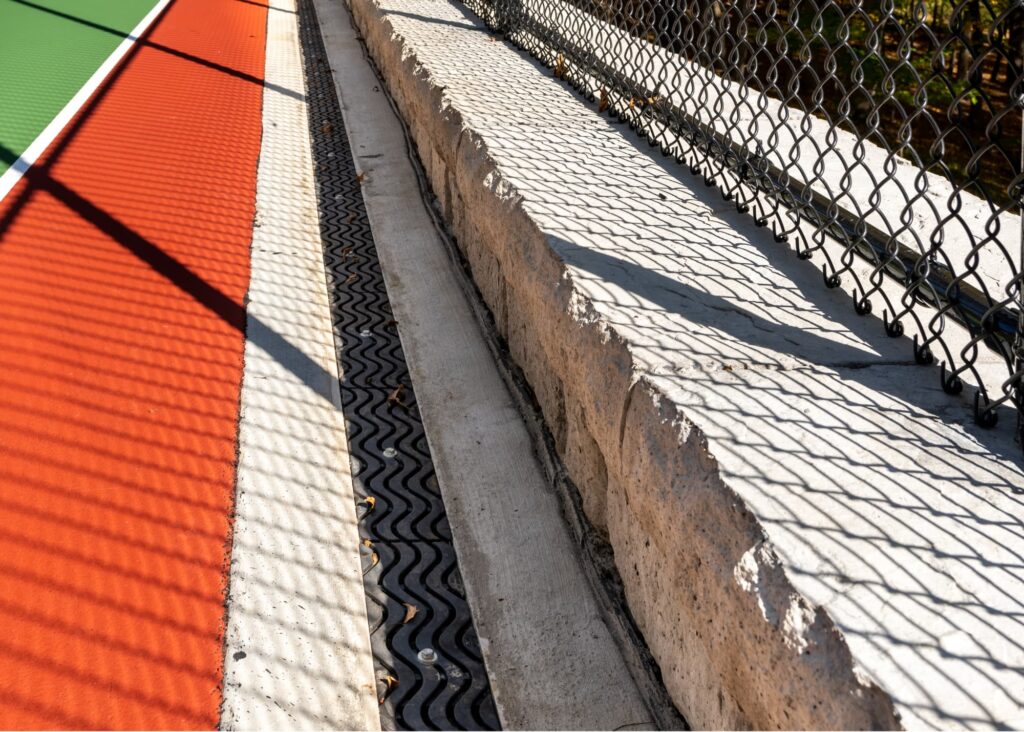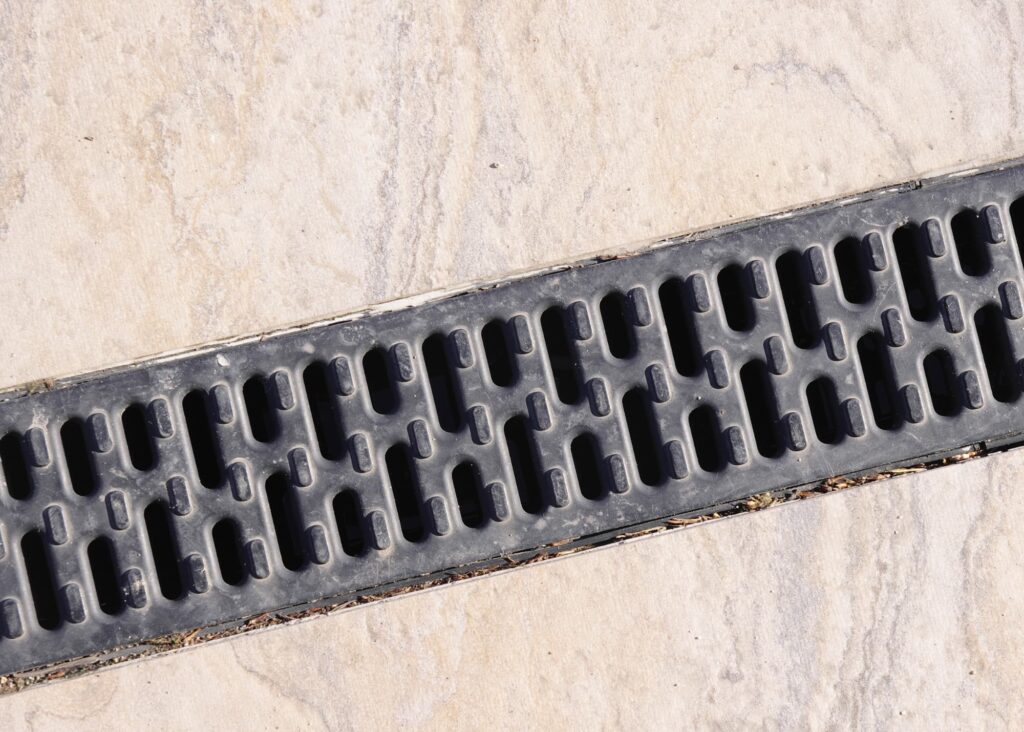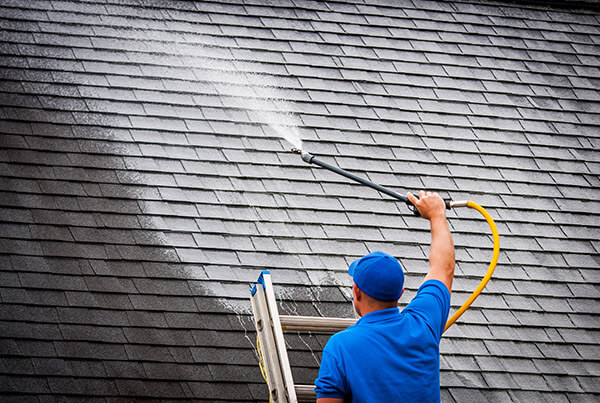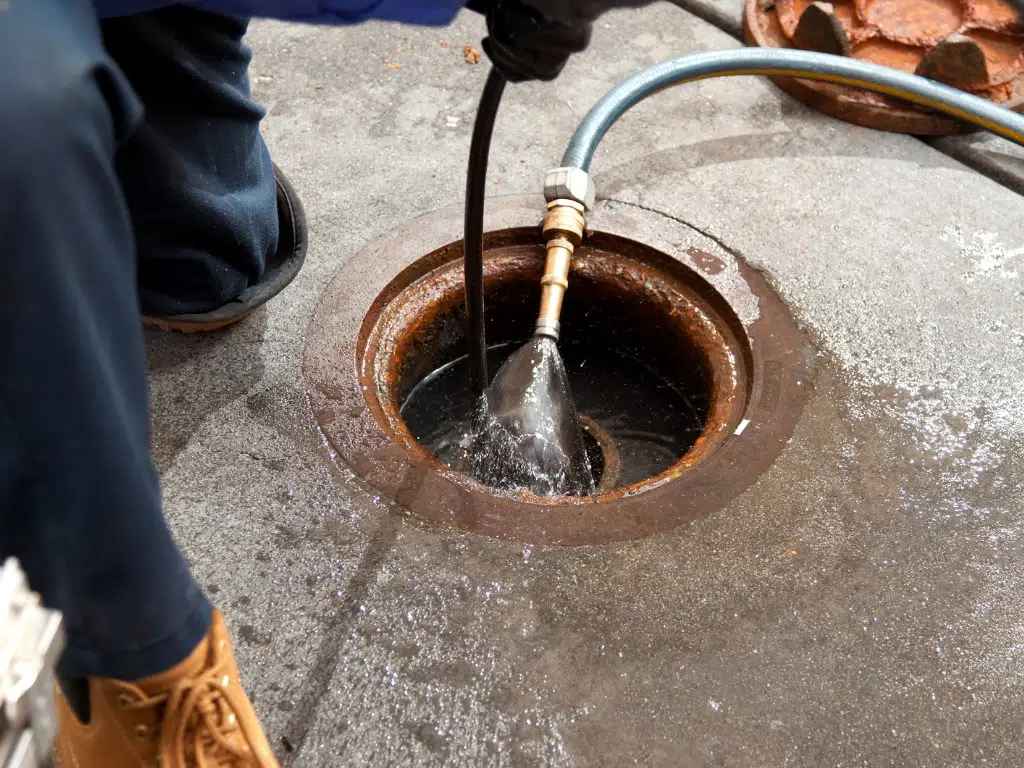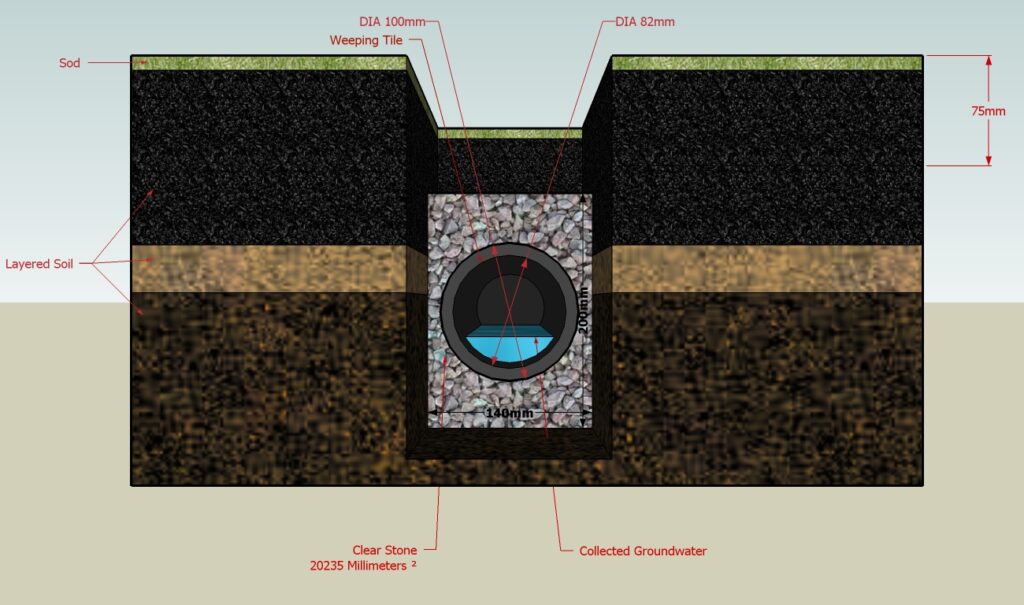Are you dealing with a waterlogged yard or basement flooding after heavy rains? At Ware Landscaping, we understand the frustration that excess water can bring to your property. That’s why we’re here to introduce you to an effective solution: trench drains.
In this guide, we’ll walk you through everything you need to know about these drainage systems and how they can transform your outdoor space.
What Is a Trench Drain?
Imagine a sleek, narrow channel running across your yard, quietly redirecting excess water before it becomes a problem. That’s the essence of a trench drain. Let’s break it down further.
A trench drain is a long, narrow gutter installed at or below ground level. It consists of two main parts: the channel (the trench itself) and a grate cover. This combination works together to collect surface water and guide it away from your property.
Common materials used in trench drains: At Ware Landscaping, we use high-quality materials to ensure your trench drain is durable and effective:
- Polymer concrete: Resistant to chemicals and weathering
- HDPE (High-Density Polyethylene): Lightweight and corrosion-resistant
- Cast iron or steel grates: Ideal for high-traffic areas requiring extra strength
How Does a Trench Drain Work?
Now that you’re familiar with what a trench drain is, let’s explore how it effectively manages water on your property.
Gravity-based water flow
Trench drains utilize the natural power of gravity. When water flows across your yard, it seeks the lowest point. Your trench drain provides that low point, capturing the water and channeling it away from your property. It’s essentially creating a controlled path for water to follow, preventing it from pooling in unwanted areas.
Importance of slope and run in trench drain functionality
This is where professional expertise becomes crucial. At Ware Landscaping, we carefully calculate the optimal slope for your drain to ensure water flows smoothly and efficiently.
The “run” (length) of your trench drain is equally important – we design it to cover all the problem areas in your yard, creating a comprehensive drainage solution.
A well-designed trench drain isn’t just functional – it can be a seamless addition to your landscape. As we continue, we’ll explore more about how these drainage systems can effectively solve your yard’s water issues and enhance your outdoor living space.
Trench Drains vs. French Drains: Understanding the Differences
When it comes to managing water on your property, you have options. Understanding the difference between French drain and Trench drain systems is crucial for choosing the right water management solution for your specific needs. While both serve the purpose of water management, they operate quite differently.
Let’s get into these differences to help you understand which might be the best drainage solution for your Chicagoland yard.
Surface vs. subsurface drainage
Trench drains: Surface water management
Trench drains are your go-to solution for surface water issues. They’re designed to capture and redirect water that’s flowing across the surface of your property. If you’ve noticed water pooling on your driveway, patio, or lawn after a rainstorm, a trench drain could be your ideal solution.
These systems work quickly, collecting water before it has a chance to saturate the ground or cause damage to your landscaping.
French drains: Subsurface water redirection
On the other hand, French drains tackle water problems below the surface. They’re excellent for areas with high water tables or where water tends to saturate the soil.
If you’re dealing with a consistently soggy lawn or water seeping into your basement, a French drain is probably going to be the right drainage solution for you. These systems work by intercepting groundwater and redirecting it away from problem areas, helping to keep your soil drier and your foundation protected.
Installation methods
Trench drains: Open channel systems
Installing a trench drain involves creating an open channel at or slightly below ground level. This channel is then fitted with a grate cover. The open nature of trench drains allows for quick water collection and easy maintenance.
At Ware Landscaping, we carefully plan the placement and slope of these channels to ensure optimal water flow and integration with your existing landscape.
French drains: Underground perforated pipes
French drains require a bit more excavation. We dig a trench and install a perforated pipe surrounded by gravel. This pipe is then covered with soil and, if desired, grass or other landscaping. The perforations in the pipe allow water to enter from the surrounding soil, carrying it away from your home or problem areas.
While less visible than trench drains, French drains work tirelessly beneath the surface to keep your yard dry.
Understanding these differences is key to choosing the right drainage solution for your property. At Ware Landscaping, we assess your specific needs and landscape to recommend the most effective drainage system, whether it’s a trench drain, French drain, or a combination of both.
Benefits of Installing a Trench Drain in Your Yard
At Ware Landscaping, we’ve seen firsthand how trench drains can transform problematic yards into beautiful, functional spaces. Here are some key benefits you can expect:
- Effective water management: Trench drains excel at quickly capturing and redirecting surface water. This means no more puddles on your patio or soggy spots on your lawn after a heavy rain. By efficiently managing water flow, trench drains help maintain a dry, usable outdoor space, even during wet seasons.
- Prevention of water damage and erosion: Left unchecked, excess water can wreak havoc on your property. It can erode soil, damage foundations, and create unsightly ruts in your lawn. Trench drains act as a protective barrier, intercepting water before it can cause these issues. This proactive approach can save you significant time and money on potential repairs down the line.
Improved landscape aesthetics: While functionality is crucial, we at Ware Landscaping also understand the importance of maintaining your yard’s visual appeal. Modern trench drains can be seamlessly integrated into your landscape design. With a variety of grate styles and materials available, we can ensure your drainage solution complements your outdoor aesthetic rather than detracting from it.
Where Does Trench Drain Water Go?
A common question we hear is, “Once the trench drain collects the water, where does it go?” The answer depends on your specific property and local regulations, but here are the two main options:
Connection to existing drainage systems or catch basins
In many cases, we can connect your trench drain to existing stormwater systems. This might involve tying into underground pipes that lead to a municipal storm sewer or directing water to a dedicated catch basin on your property. These connections ensure that the collected water is properly managed and doesn’t simply create a new problem area elsewhere in your yard.
Proper water redirection away from structures
When connection to existing systems isn’t feasible, we focus on redirecting water to appropriate areas of your property. This might involve creating a dry well, where water can slowly percolate into the ground, or directing flow to a rain garden or other landscaped area designed to handle excess water.
The key is to move water away from your home’s foundation and other vulnerable structures, dispersing it safely where it won’t cause damage.
At Ware Landscaping, we carefully assess your property’s unique characteristics and local regulations to determine the most effective and compliant method for managing the water collected by your trench drain. Our goal is always to create a solution that not only solves your immediate drainage issues but also integrates seamlessly with your overall landscape and local ecosystem.
Can You Use a Trench Drain in a Yard?
Absolutely! We often recommend trench drains as versatile solutions for residential landscapes. They’re not just for commercial or industrial settings – trench drains can be an excellent addition to your yard, solving a variety of drainage issues while maintaining the beauty of your outdoor space.
Versatility of trench drains in residential landscapes
Trench drains can be adapted to suit various yard sizes and layouts. Whether you have a small urban garden or a sprawling suburban lawn, we can design a trench drain system that fits your needs. These drains can be customized in length, width, and depth to handle the specific water volume and flow rate of your property.
Common yard applications
- Driveways: Trench drains installed across the bottom of sloped driveways prevent water from flowing into your garage or basement.
- Patios: A well-placed trench drain can keep your outdoor living area dry and usable, even after heavy rain.
- Pool areas: Trench drains around pool decks help manage splash-out and rainwater, reducing slip hazards and maintaining proper pool water chemistry.
- Lawn perimeters: Installing trench drains along the edges of your lawn can prevent water from neighboring properties from saturating your yard.
Potential Disadvantages of Trench Drains
While trench drains offer numerous benefits, it’s important to consider all aspects before making a decision. At Ware Landscaping, we believe in providing our clients with comprehensive information. Here are some potential drawbacks to consider:
Initial installation costs
Installing a trench drain system involves excavation, materials, and skilled labor. The upfront cost can be higher compared to some other drainage solutions. However, it’s important to weigh this against the long-term benefits and potential savings from prevented water damage.
Maintenance requirements
To function effectively, trench drains need regular maintenance. This typically involves:
- Periodic cleaning to remove debris
- Checking and clearing the grates
- Ensuring the drain remains free-flowing
While not overly time-consuming, this maintenance is crucial for the system’s longevity and effectiveness.
Addressing clogging issues
Like any drainage system, trench drains can potentially clog with leaves, soil, or other debris. In areas with heavy leaf fall or sediment runoff, this might require more frequent attention. However, with proper design and regular maintenance, clogging can be minimized.
At Ware Landscaping, we address these potential disadvantages through thoughtful design, quality materials, and educating our clients on proper maintenance. We also offer maintenance services to ensure your trench drain continues to function optimally year after year.
Remember, while these factors are important to consider, they often pale in comparison to the benefits of a dry, usable yard and the prevention of costly water damage.
Our team is always available to discuss whether a trench drain is the right solution for your specific situation.
Choosing the Right Trench Drain for Your Yard
At Ware Landscaping, we understand that every yard is unique. Selecting the right trench drain system involves careful consideration of several factors to ensure you get a solution that’s both effective and suited to your specific needs.
Factors to consider
Yard size
The size of your property plays a crucial role in determining the appropriate trench drain system. Larger yards may require longer runs or multiple drains to effectively manage water flow, while smaller spaces might need more compact, strategically placed solutions.
Water volume
We assess the amount of water your property typically deals with during heavy rains or snow melts. This helps us determine the necessary capacity of your trench drain system. Factors like local rainfall patterns, surrounding landscape grade, and runoff from neighboring properties all come into play.
Aesthetics
Your trench drain doesn’t have to be an eyesore. We offer various grate designs and materials that can complement your existing landscape. Whether you prefer a subtle, barely noticeable drain or a design element that adds to your yard’s visual appeal, we can find a solution that fits your style.
Soil type
The composition of your soil affects how water moves through your property. Clay soils, for instance, may require more robust drainage solutions compared to sandy soils that naturally drain better.
Local building codes
We ensure that any drainage solution we propose complies with local regulations and building codes. This is crucial for both the legality and effectiveness of your system.
Professional assessment and recommendations
At Ware Landscaping, we don’t believe in one-size-fits-all solutions. That’s why we always start with a thorough on-site assessment. Here’s what you can expect:
- Site evaluation: We’ll visit your property to observe its unique characteristics, identify problem areas, and assess the overall drainage patterns.
- Discussion of needs: We’ll talk with you about your specific concerns, how you use your outdoor space, and your long-term landscaping goals.
- Custom solution design: Based on our assessment and your input, we’ll design a trench drain system tailored to your property’s needs and your personal preferences.
- Detailed recommendations: We’ll provide you with clear, understandable recommendations, explaining why we believe certain options are best for your situation.
- Future-proofing: We consider not just your current needs, but potential future changes to your landscape or local climate patterns.
Our goal is to provide you with a trench drain solution that effectively manages water, enhances your property’s usability, and adds value to your home. With our expertise and your input, we can create a drainage system that you’ll appreciate for years to come.
Remember, the right trench drain is an investment in your property’s health and your peace of mind. Don’t hesitate to reach out to us for a professional assessment – we’re here to help you make the best choice for your yard.
Trench Drain Installation Process
At Ware Landscaping, we pride ourselves on our meticulous installation process. Here’s an overview of what you can expect:
- Site Preparation: We carefully mark the drain location and prepare the area for excavation.
- Excavation: We dig the trench to the proper depth and grade, ensuring optimal water flow.
- Base Installation: A solid base is laid to support the drain and prevent shifting.
- Drain Placement: We position the drain channels, ensuring proper alignment and connections.
- Concrete Pouring: For maximum stability, we often set the drain in concrete.
- Grate Installation: We secure the chosen grates in place.
- Final Grading: We ensure the surrounding area properly directs water into the drain.
- Clean-up and Testing: We thoroughly clean the area and test the system to ensure proper function.
Importance of proper installation for optimal performance
A correctly installed trench drain is crucial for long-term performance. Proper grading, secure positioning, and appropriate connections all contribute to a system that effectively manages water for years to come. Our experienced team ensures every detail is addressed, from the initial slope calculations to the final testing phase.
Transform Your Yard with Ware Landscaping’s Trench Drain Solutions
Don’t let water issues dampen your outdoor enjoyment. Ware Landscaping is here to help you reclaim your yard with our expert trench drain solutions.
Benefits of professional installation
- Customized solutions tailored to your specific property needs
- High-quality materials and workmanship for long-lasting results
- Compliance with local codes and regulations
- Minimal disruption to your existing landscape
Ware Landscaping’s expertise in yard drainage solutions
With years of experience in the Chicagoland area, we understand the unique drainage challenges our region faces. Our team combines local knowledge with industry-leading techniques to provide drainage solutions that stand the test of time. We’re not just installing a drain; we’re creating a comprehensive water management system for your property.
Ready to solve your yard’s water woes? Take the first step towards a drier, more beautiful outdoor space. Call us at 630-912-7691 or contact Ware Landscaping today for a consultation. Our experts will assess your property, discuss your needs, and design a trench drain solution that works for you.
Don’t wait for the next big rainstorm to highlight your drainage issues. Remember, at Ware Landscaping, we’re not just improving yards – we’re enhancing lifestyles, one drainage solution at a time.


